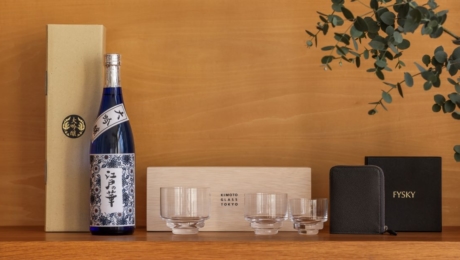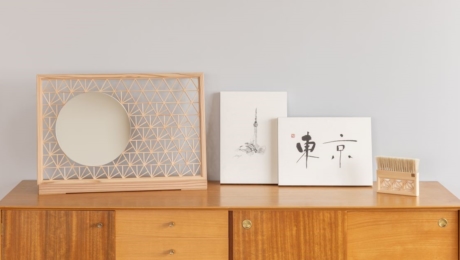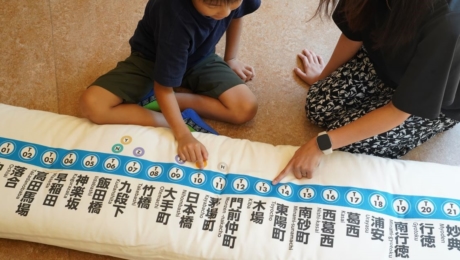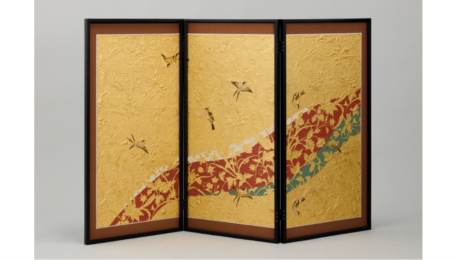![[Edo Tokyo Rethink Exhibition]Collaboration works by contemporary artist Noritaka Tatehana, utilizing the skills of a master craftsman.](https://en.edotokyokirari.jp/wp-content/uploads/20240322122905/334f227d62e25f7ecb57517848fefa79.jpg)
![[Edo Tokyo Rethink Exhibition]Collaboration works by contemporary artist Noritaka Tatehana, utilizing the skills of a master craftsman.](https://en.edotokyokirari.jp/wp-content/uploads/20240322122919/90ffce2e1f97fd099cf868cc473fa489-750x750.jpg)
[Edo Tokyo Rethink Exhibition]
Collaboration works by contemporary artist Noritaka Tatehana, utilizing the skills of a master craftsman.
2024.03.27
LIFEBased on the concept “old meets new,” the Edo Tokyo Kirari Project was conceived to introduce the timeless appeal of Tokyo both to Japan and to the wider world. This is an appeal embodied by the many venerable shops that have carried on the flame of craftsmanship, culture, and tradition in the city over the centuries, from the Edo period to the modern day. As an offshoot of the project, I have joined the Edo Tokyo Rethink exhibition, as both a contributing artist and exhibition director. In the past, I have held a number of other exhibitions bearing the title “Rethink.” However, I believe this project’s theme, “old meets new,” dovetails particularly well with the notion I have sought to convey with the word “rethink.” In essence, Japan’s traditions and culture have been handed down over the generations, in a seamless, unbroken chain. Rather than merely rehashing these traditions in the modern age, we should rethink our heritage, adding an extra layer of modern meaning and reinterpretation. You could say that all of my work is predicated on the full accretion of Japanese history and culture. In that sense, I see “old meets new” as being synonymous with the act of rethinking. My career has been a constant process of connecting past and present, across myriad collaborations with traditional crafts and performing arts. In order to preserve our traditions for the next 100 years, we must ask what we can do in the present, identifying what should change with the times, and what should remain the same. What modern meaning will we add, now that it is our turn to define tradition? The present exhibition serves to introduce the many charms of Tokyo, while also presenting all of us an opportunity to rethink old and new.
Edo Tokyo Kirari Project Promotion Committee
Edo Tokyo Rethink Exhibition Director
Contemporary Artist Noritaka Tatehana
![[Edo Tokyo Rethink Exhibition]Collaboration works by contemporary artist Noritaka Tatehana, utilizing the skills of a master craftsman.](https://en.edotokyokirari.jp/wp-content/uploads/20240325150543/7c3d3021af5861bf45d6f0dc7edf2109.png)
Collaboration works by contemporary artist Noritaka Tatehana, utilizing the skills of a master craftsman
“Edo Tokyo Rethink −Fusion of Takumi Craftsmanship and Contemporary Art Perceived at the Kyu-Iwasaki-tei Gardens−” was open to the public from March 1 to March 10, 2024 at the Kyu-Iwasaki-tei Gardens, an Important Cultural Property. Collaboration works by the model businesses of the Edo Tokyo Kirari Project and contemporary artist Noritaka Tatehana were unveiled. On this page, we would like to introduce a series of collaborative artworks that utilize the skills of master craftsmen.
![[Edo Tokyo Rethink Exhibition]Collaboration works by contemporary artist Noritaka Tatehana, utilizing the skills of a master craftsman.](https://en.edotokyokirari.jp/wp-content/uploads/20240322123229/737d4cd77e0117f2b8e4acf55ba486ff.jpg)
Noritaka Tatehana x Wadaiko Miyamoto Unosuke Shoten
This work portrays the thunderous roar announcing the coming of gods, made by the drums of Raijin, the god of thunder. These drums were created by connecting small 4.5 sun (5.3 inch) drums called gangu daiko or “the toy drums.” After the craftsmen of Miyamoto Unosuke Shoten connected the drums in a circle, they were painted at the atelier of contemporary artist, Noritaka Tatehana. The drums used for this work were those which couldn’t be finished as a product back in the Showa 50s (1975-1984) because they were distorted or cracked during the drying process prior to stretching the skin over the drumheads.
![[Edo Tokyo Rethink Exhibition]Collaboration works by contemporary artist Noritaka Tatehana, utilizing the skills of a master craftsman.](https://en.edotokyokirari.jp/wp-content/uploads/20240322123328/16166b378cf73456b3be44f444f0a2a8.jpg)
Noritaka Tatehana x Tokyo Kumihimo Ryukobo
The pure silk “square cord” which has different colors on the front and back, was created specifically for this work of art. Inspired by the chic lining of kimono or “haura” which represents the aesthetic taste of Edo, the cord, as an accent color, adds a rich expression to seemingly a monotone work. The knots precisely placed at a pitch of 60mm give a three-dimensional texture. The appearance enhanced by the collective knots acts as an important accent of the artwork. Furthermore, the curvy lines created by the inserted color in the braided cord using the “Fuji Yotsu-gumi” or the Fuji 4-strand-round braid add intonation to the appearance. The decorative knots on the back called “Kissho Musubi” has long been believed to bring good luck.
![[Edo Tokyo Rethink Exhibition]Collaboration works by contemporary artist Noritaka Tatehana, utilizing the skills of a master craftsman.](https://en.edotokyokirari.jp/wp-content/uploads/20240322123429/99e2225fbd74183fa7c496df1d1f02f3.jpg)
Noritaka Tatehana x Edo Hake / Tokyo Teue Brush Uno Brush
When mass production using automated technology is the mainstream, Uno Brush adheres to producing hand-planted hake and brushes. In collaboration with Uno Brush, Noritaka Tatehana succeeded in creating a new type of painting technique using the “sakan” brushes or plastering brushes, which have been produced for centuries, to add a finishing touch to his artwork. This technique was studied with the aim of utilizing the stripe-like traces created by drawing the plastering brush on the surface of the painting. In the world of painting, these engraved brush strokes are called “hitchi. ” The plastering brushes used for this work were made of elastic hairs of a horse’s tail and the longest brush which was specially made, is 60cm wide.
![[Edo Tokyo Rethink Exhibition]Collaboration works by contemporary artist Noritaka Tatehana, utilizing the skills of a master craftsman.](https://en.edotokyokirari.jp/wp-content/uploads/20240322123528/28d7b59900edb225c34311557bdd3c65.jpg)
Noritaka Tatehana x Edo Uchiwa / Edo Sensu Ibasen
The Edo sensu or the folding fan was created as an extension of Noritaka Tatehana’s painting series known as the “Duality Painting” which incorporates a pair of elements in a single painting. Taking advantage of the fan surface which folds into a bellows shape, different motifs emerge on a single fan, depending on the angle of view. In addition, the full moon designed on the “Dai Mangetsu Uchiwa” or the large Edo Full Moon Fan was drawn especially for this work. Edo uchiwa fans are made by splitting a single piece of bamboo and this intricate craftwork technique make them equally attractive as the Edo sensu.
![[Edo Tokyo Rethink Exhibition]Collaboration works by contemporary artist Noritaka Tatehana, utilizing the skills of a master craftsman.](https://en.edotokyokirari.jp/wp-content/uploads/20240322123623/8c6e0705c18434d1e36561d8cda193fc.jpg)
Noritaka Tatehana x Kinkarakawashi Kinkarakami Institute (Special Cooperation)
The “Heel-less Shoes” which Noritaka Tatehana created for this exhibition were made using kinkarakawashi (Japanese gold embossed leather paper) produced by Kinkarakami Institute which participated as a special collaborator. Japanese people first came to know of this decorative gilded faux leather called kinkarakawa from Europe in the Edo Period and recreated it using Japanese washi paper. After the Meiji Period, the Japanese kinkarakawashi gained such popularity that it was exported overseas. Unfortunately, the demand gradually declined and by mid-Showa, even the production technique had ceased to exist. Kinkarakawashi is also used in the Western-style rooms of the Kyu-Iwasaki-tei Gardens, the venue for this exhibition. The person who was involved in this restoration project was Mr. Takashi Ueda, the founder of Kinkarakami Instituten and the national bearer of the selected preservation technique.
![[Edo Tokyo Rethink Exhibition]Collaboration works by contemporary artist Noritaka Tatehana, utilizing the skills of a master craftsman.](https://en.edotokyokirari.jp/wp-content/uploads/20240322123720/d8cddf2e3b036d86ac3d017bd7459a69.jpg)
Noritaka Tatehana x Tokyo Chusen Marukyu Shoten
The outsoles of the heel-less shoes, dyed using “chusen,” a traditional dyeing process, feature Noritaka Tatehana’s signature motif, the thundercloud. This piece of artwork was created utilizing chusen’s unique characteristics, which make it possible to simultaneously dye a pattern in various vivid colors using one stencil. In addition, making use of the height of the work, the characteristic gradation technique of chusen was applied to the design which extends vertically, therefore creating a work of art that combines the craftsman’s fastidious attention to techniques and Tatehana’s scrupulous attention to details.
![[Edo Tokyo Rethink Exhibition]Collaboration works by contemporary artist Noritaka Tatehana, utilizing the skills of a master craftsman.](https://en.edotokyokirari.jp/wp-content/uploads/20240322123813/aa10e0c0c3f79e18df25abc22541e1c7.jpg)
Noritaka Tatehana x Edo Kumiko Tatematsu
In this project collaboration with Tatematsu which specializes in employing elaborate techniques of Japanese woodwork or Kumiko-zaiku to create diverse products, Noritaka Tatehana’s thundercloud motif, painted in acrylic, is portrayed overlaying the traditional geometric patterns of Kumiko-zaiku. The patterns used depict the four seasons: from the top to bottom respectively, “Sakura Kikko” or the cherry blossom tortoise shell, “Kawari-Asanoha” or the double hemp leaf, “Kikyo Kikko” or the bellflower tortoise shell, and “Yukigata Kikko” or the snow-shaped tortoise shell. Among these, the hemp leaf and the bellflower patterns are thought to be a good omen just like Tatehana’s thundercloud, therefore linking the motifs to each other.
Photo by GION





